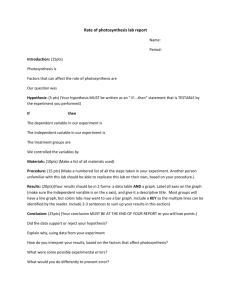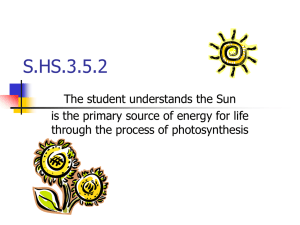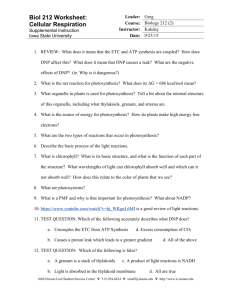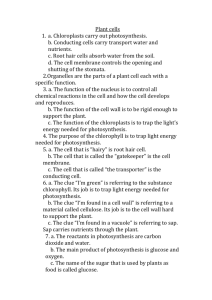Task - Science - Grade 5
advertisement
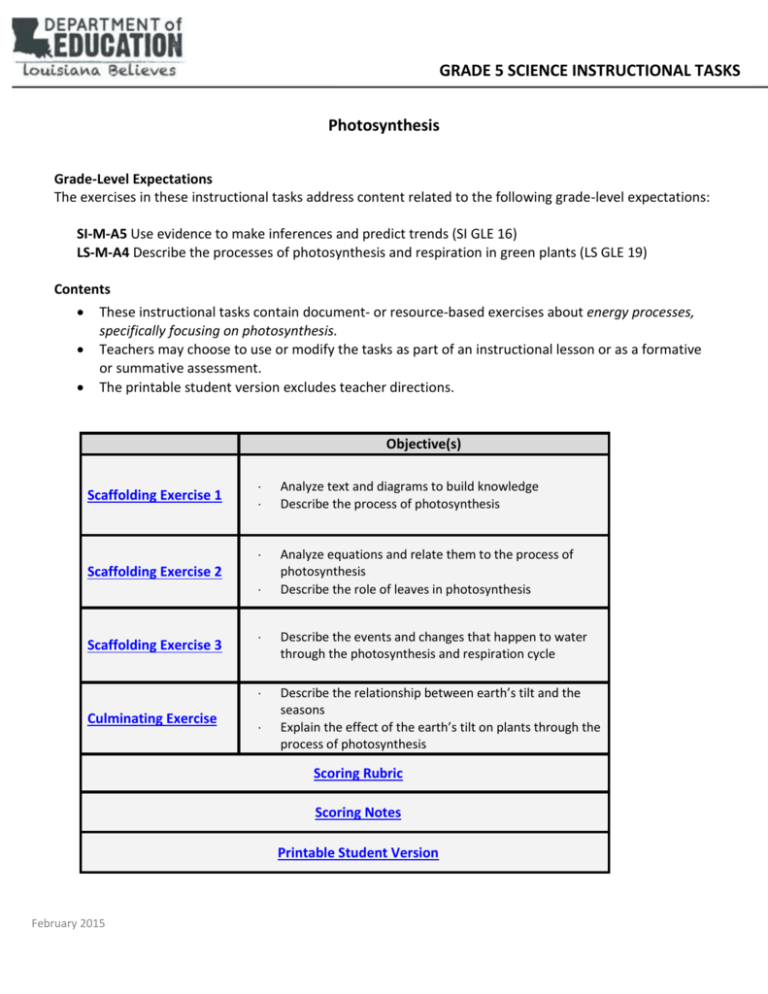
GRADE 5 SCIENCE INSTRUCTIONAL TASKS Photosynthesis Grade-Level Expectations The exercises in these instructional tasks address content related to the following grade-level expectations: SI-M-A5 Use evidence to make inferences and predict trends (SI GLE 16) LS-M-A4 Describe the processes of photosynthesis and respiration in green plants (LS GLE 19) Contents These instructional tasks contain document- or resource-based exercises about energy processes, specifically focusing on photosynthesis. Teachers may choose to use or modify the tasks as part of an instructional lesson or as a formative or summative assessment. The printable student version excludes teacher directions. Objective(s) Scaffolding Exercise 1 Scaffolding Exercise 2 Scaffolding Exercise 3 Culminating Exercise Analyze text and diagrams to build knowledge Describe the process of photosynthesis Analyze equations and relate them to the process of photosynthesis Describe the role of leaves in photosynthesis Describe the events and changes that happen to water through the photosynthesis and respiration cycle Describe the relationship between earth’s tilt and the seasons Explain the effect of the earth’s tilt on plants through the process of photosynthesis Scoring Rubric Scoring Notes Printable Student Version February 2015 Teacher Directions: Have students read the text excerpt and analyze the diagram to respond to the prompts below. Scaffolding Exercise 1 Photosynthesis Plants and animals are very different. Animals must consume food to obtain energy. Plants, algae, and some bacteria are producers— they can make their own food. Photosynthesis is the process by which organisms use energy from the sun and water to make their own food (sugars). During photosynthesis, plants and other producers get carbon dioxide from the air. Some of this carbon dioxide comes from people and other animals that release it when they breathe. Photosynthesis produces oxygen and sugar in the form of glucose (food for energy). Excess oxygen as a byproduct of photosynthesis is released from the leaves into the air. Plants use some of the glucose for energy, store some to use later, and use some to build plant parts. Your partner makes the claim that plants get all the materials they need for growth and functioning from the sun, air, and water. Help your partner support this claim. Write a paragraph that supports your partner’s claim that: explains what the claim means, and includes two relevant pieces of evidence from the passage. Teacher Directions: Have students respond to the prompt below. Scaffolding Exercise 2 Describe the role of a leaf in photosynthesis. Your writing should include the following words: chloroplasts, chlorophyll, light, energy, water, carbon dioxide, and stomata. Use the equations below as an aid. sunlight Water + carbon dioxide sugar (glucose) + oxygen chlorophyll Sugar (glucose) + oxygen carbon dioxide + water + energy Teacher Directions: Scaffolding Exercise 3 Have students describe the events and changes that happen to oxygen and hydrogen atoms during photosynthesis and in the aerobic respiration cycle depicted below. Use the diagram below as a starting point but be sure to include more specific descriptive vocabulary in the writing. Include illustrations. Plant produces oxygen Plant uses carbon to make sugar molecules Animal takes in oxygen Photosynthesis/ Aerobic Respiration Cycle Animal breaks down sugar molecules Plant takes in carbon dioxide Animal releases carbon dioxide Culminating Exercise As the earth spins on its axis producing night and day, it also moves about the sun in an orbit that requires about 365 ¼ days to complete the full orbit. The earth's spin axis is tilted at an angle. This is what causes the seasons. When the northern hemisphere is pointed towards the sun, it is summer for that hemisphere. When the earth's axis points away, it is winter for that hemisphere. Spring and autumn occur in between these extremes. Windows to the Universe original image Analyze how the tilt of the earth on its axis affects the process of photosynthesis in plants. A. B. C. D. Explain how the tilt of the earth causes the seasons. Describe how this affects photosynthesis in plants. Analyze the rate of photosynthesis at different times of the year. Determine the relationship between leaves that change colors on some plants and the tilt of the earth on its axis. Rubric Key Elements: A. The response correctly explains the relationship between of earth’s tilt and the seasons. B. The response describes the effect of the seasonal changes on the photosynthesis. C. The response describes how the seasons alter the rate of photosynthesis. D. The response explains the relationship between the tilt of the earth on its axis and the color change in leaves on some plants. Response includes all four key elements. 4 Points Response contains no scientific errors. Response includes three of the four key elements. 3 Points Response may include scientific errors. Response includes two of the four key elements. 2 Points Response may include scientific errors. Response includes one of the four key elements. 1 Point Response may include scientific errors. Scoring Notes The following are examples only. All reasonable, valid responses should be accepted. A. Earth’s tilt on its axis toward or away from the sun determines which part of the earth receives the most intense, direct sunlight during each season. The intensity of the sunlight on a region of the earth is the primary cause for the climatic changes that are called seasons. Summer in the northern hemisphere occurs at the same time as winter in the south, and vice-versa. For the northern hemisphere, the axis points most toward the sun in June (specifically around June 21) which is summer, and away from the sun around December 21 which is winter. For the southern hemisphere, this is reversed. B. The intensity of the sunlight on a specific part of the earth and the variation in the length of days changes the amount of energy received from sunlight and the temperature of the environment. These changes result in changes the amount of photosynthesis that occurs in all plants. C. The seasons influence the rate of photosynthesis because each season has a difference in the amount of direct sunlight, length of days and temperature. More direct sunlight for longer periods of time and warm temperatures increases the rate of photosynthesis. During the summer, the rate of photosynthesis in plants is very high producing rapid growth and high oxygen production. Spring has the second greatest rate of photosynthesis due the gradual increase in direct sunlight and temperature. During fall, the rate of photosynthesis declines as less direct sunlight is received and the temperature lowers. During this season, plants receive more indirect sunlight and the temperature decreases. In winter, the rate of photosynthesis is the lowest. Photosynthesis stops as temperatures near the freezing point. D. In summer, the leaves produce more chlorophyll resulting in bright to intense green leaves. As fall approaches, the days quickly shorten, and the nights quickly cool as the earth’s tilt becomes more neutral. This triggers the some plants, such as trees, to reduce chlorophyll production and start the yearly display of colors. Some of the excess chlorophyll leaches out of the plant. With less chlorophyll in the plant, the other pigments in the leaves such as reds, purples, and yellows become more visible in the leaves. In the winter, when it is cold, there is much less chlorophyll production when the earth tilts away from the sun. In some plants the chlorophyll production stops as the temperature cools resulting in the leaves turning brown and falling off the plant. Other Resources: http://www.nclark.net/PhotoRespiration http://www.biology4kids.com/files/plants_photosynthesis.html http://www.weatherquestions.com/What_causes_the_seasons.htm http://spaceplace.nasa.gov/seasons/en https://www.youtube.com/watch?v=rwA1QVsbD6g Printable Student Version Photosynthesis Plants and animals are very different. Animals must consume food to obtain energy. Plants, algae, and some bacteria are producers—they can make their own food. Photosynthesis is the process by which organisms use energy from the sun and water to make their own food (sugars). During photosynthesis, plants and other producers get carbon dioxide from the air. Some of this carbon dioxide comes from people and other animals that release it when they breathe. Photosynthesis produces oxygen and sugar in the form of glucose (food for energy). Excess oxygen as a byproduct of photosynthesis is released from the leaves into the air. Plants use some of the glucose for energy, store some to use later, and use some to build plant parts. Your partner makes the claim that plants get all the materials they need for growth and functioning from the sun, air, and water. Help your partner support this claim. Write a paragraph that supports your partner’s claim by: explaining what the claim means, and include two relevant pieces of evidence from the passage. Describe the role of a leaf in photosynthesis. Your writing should include the following words: chloroplasts, chlorophyll, light, energy, water, carbon dioxide, and stomata. Use the equations below as an aid. sunlight Water + carbon dioxide sugar (glucose) + oxygen chlorophyll Sugar (glucose) + oxygen carbon dioxide + water + energy Describe the events and changes that happen to oxygen and hydrogen atoms during photosynthesis and in the aerobic respiration cycle depicted below. Use the diagram below as a starting point but be sure to include more specific descriptive vocabulary in the writing. Include illustrations. Plant produces oxygen Plant uses carbon to make sugar molecules Animal takes in oxygen Photosynthesis/ Aerobic Respiration Cycle Animal breaks down sugar molecules Plant takes in carbon dioxide Animal releases carbon dioxide As the earth spins on its axis producing night and day, it also moves about the sun in an orbit that requires about 365 ¼ days to complete the full orbit. The earth's spin axis is tilted at an angle. This is what causes the seasons. When the northern hemisphere is pointed towards the sun, it is summer for that hemisphere. When the earth's axis points away, it is winter for that hemisphere. Spring and autumn occur in between these extremes. Windows to the Universe original image Analyze how the tilt of the earth on its axis affects the process of photosynthesis in plants. A. B. C. D. Explain how the tilt of the earth causes the seasons. Describe how this affects photosynthesis in plants. Analyze the rate of photosynthesis at different times of the year. Determine the relationship between leaves that change colors on some plants and the tilt of the earth on its axis.




